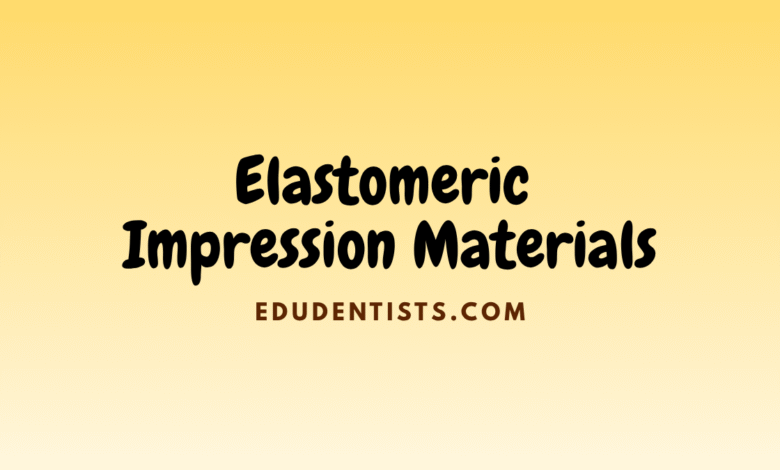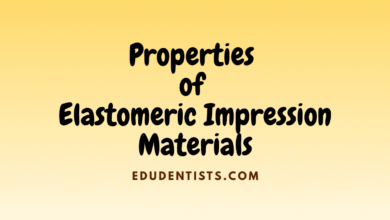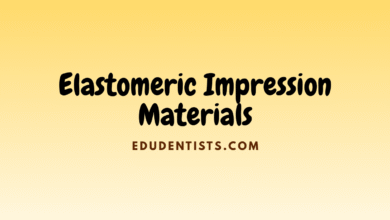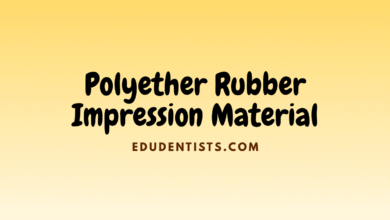
Elastomeric Impression Materials
Elastomeric Impression Materials
Elastomeric impression materials are a group of elastic, rubber-like materials used in dentistry. They are stronger and more dimensionally stable than hydrocolloids, making them highly accurate for dental impressions. These materials are often referred to as elastomers or synthetic rubbers, and the ADA Specification No. 19 classifies them as nonaqueous elastomeric dental impression materials.
Structure and Chemistry
Elastomers are made of long polymer chains with weak intermolecular forces, which are connected at various points to form a 3D network. When stretched, the chains uncoil, and when the force is removed, they return to their original entangled state. These materials start as liquid polymers and become solid rubber at room temperature through a process called polymerization and cross-linking—either by condensation or addition reactions.
Synonyms
Originally known as rubber-base impression materials, today they are called elastomeric impression materials.
Historical Timeline
- 1950 – Polysulfide
- 1955 – Condensation Silicone
- 1965 – Polyether
- 1975 – Addition Silicone
Types of Elastomers
According to Chemistry
- Polysulfide
- Condensation Silicone
- Addition Silicone
- Polyether
- Specialized Impression Materials:
A. Light-Cured Polyether Urethane Dimethacrylate
B. Bite Registration Silicones
– Used to record occlusal relationships.
– These are stiffer and harder (32–45 Shore D).
– Quick setting (20 sec–1 min).
– Designed not to slump or drip.
– Some versions are scannable for CAD-CAM (e.g., Virtual CADbite, Ivoclar).
– Supplied in cartridges or collapsible tubes.
– Example: Colorbite D (Zhermack) has a thermochromic indicator for intraoral setting confirmation.
D. Fit-Checking Silicones
– Specialized silicones used to assess internal fit of crowns and fixed prostheses.
– Supplied as a two-paste system.
– Mixed and applied to crown’s internal surface, then seated on the tooth.
– Areas of premature contact are revealed as thin or void areas.
– Also used for checking fit of dentures.
According to Viscosity
Each type is available in different viscosities:
- Light body (syringe consistency)
- Medium body
- Heavy body
- Very heavy body (putty)

Elastomers are available in different viscosities and forms.
ADA/ISO 4823 Classification
Based on elastic properties and dimensional changes, they are categorized into:
- Type I
- Type II
- Type III
According to Wettability
- Hydrophilic: Contact angle 40°–70°
- Hydrophobic: Contact angle 80°–105°
Uses of Elastomeric Impression Materials
- Impressions for fixed partial dentures
- Removable partial denture impressions
- Complete denture impressions
- Border molding for edentulous trays (especially polyether)
- Bite registrations
- Silicone duplicating materials for refractory casts
Forms and Packaging
All types are supplied as two-component systems (base + catalyst):
- Tubes (for collapsible pastes)
- Cartridges (for automix tips and dispensers – light/regular body)
- Jars (for putty form)
General Properties
- High detail reproduction—especially in low viscosity forms.
- Mostly hydrophobic (except polyether, which is hydrophilic)—requires dry oral environment.
- Elastic recovery is nearly complete, allowing for multiple pours (though not always recommended).
- Thermal contraction occurs from mouth to room temperature.
- Dimensional changes can occur due to:
- Curing shrinkage
- Byproduct loss (e.g., alcohol or volatile substances)
- Water absorption (especially in polyethers)
- Early removal or deformation
- Filler content (less shrinkage in putty, more in light body)
- Tray adhesion: Stronger adhesion = better dimensional accuracy.
- Pouring time: Best poured after elastic recovery, but before shrinkage begins.
- Tear strength is excellent, even in thin sections.
- Electroplatable with copper or silver.
- Tray adhesives (not interchangeable between types) or mechanical retention (perforated trays) are necessary.
- Shelf life: ~2 years (shorter for silicones); store in cool conditions.




